#yuka odajima
Text
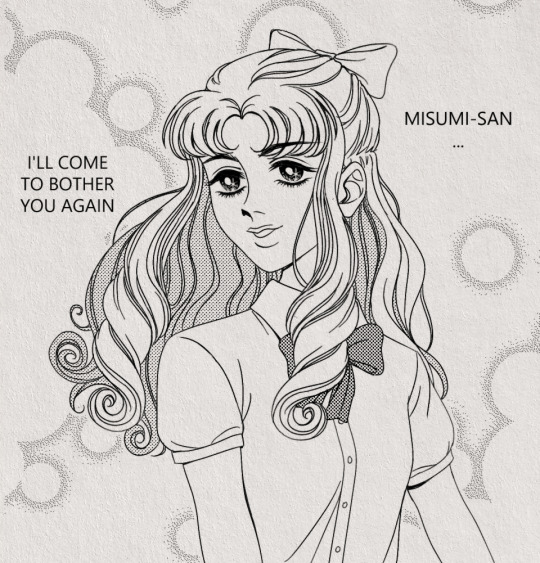
i was watching futari wa (max heart) and yuka was seriously acting like she had a crush on nagisa. like confessing her feelings while the other party is asleep classic yuri stuff. a friend mentioned how she's literally designed like a 70's yuri character so, here we are
71 notes
·
View notes
Text
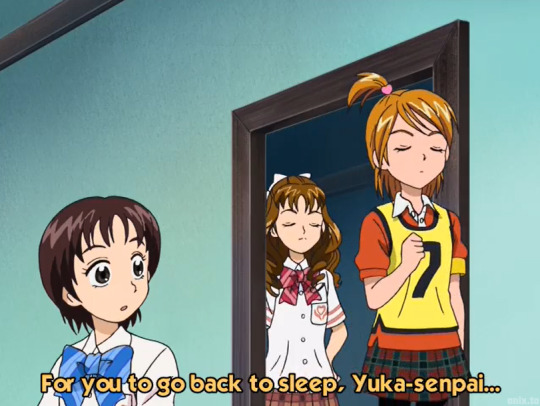


Afraid to say that I am no longer on the NagiHono train; I have descended to rare pair hell, NagiYuka all the way.
#futari wa precure#futari wa pretty cure max heart#max heart#nagisa misumi#yuka odajima#Seriously#the heartfelt confession that Yuka's life at high school feels empty without Nagisa there to cheer her up#Yuka inserting herself into the middle school trip *just* to see Nagisa again#Nagisa being so eager to draw Yuka into the lacrosse club#Nagisa seeming all embarassed and flattered when she finds out that Yuka joined the trip just to see her.#Yuka wistfully looking out the car window and thinking how she'll return to see Nagisa next time she needs cheering up#anime#pretty cure#precure
12 notes
·
View notes
Note
precure for the fandom thing?
OH FUCK YEAHHHH
blorbo - nagisa misumi. this girl has lived rent free in my head since 2018. i love her sm. idk if anyone is still around from that era but i had the biggest most embarrassing crush on her at age 14
scrunkly - rio kuroki. justice for cure waffle!!! he was so robbed!!! i would commit violence for him he is my son
scrimblo bimblo - itsuki myoudouin! i feel like she gets overshadowed by the other heartcatch characters (and don't get me wrong, i love the others, but itsuki just really clicked with me for whatever reason when i watched it)
glup shitto - yuka odajima from futari wa, she's wonderful and should've been in more episodes. i may be the world's only nagisa/yuka shipper but i am also its greatest soldier
poor little meow meow - can i say rio again. i know he's not really controversial/problematic by any means (though while i wouldn't say he's unpopular, i would say that his fans are a vocal minority, at least when going by the tumblr tags) but he just has that energy. otherwise, maybe aguri? i know she's consistently ranked pretty low popularity-wise (and i haven't watched dokidoki yet so maybe my opinion will change if i do) but i really like her aesthetic and design
horse plinko - yukari kotozume because it'd be funny. she'd probably torment me more than i'd torment her
eeby deeby - okay this might be a little controversial here. ciel kirahoshi. mostly because i have incredibly mixed feelings on her (someday when i finish kirakira i will write my great kirahoshi & kuroki essay i've been cooking in my brain all these months). like i genuinely can't decide if i like her or not. like she has good moments here and there but then she either does something stupid or the narrative simps for her too hard and i dislike her again. maybe superhell is a little drastic but i can't think of anyone else. ciel is genuinely the most disappointing cure in my opinion
#precure#pretty cure#futari wa precure#heartcatch precure#kirakira precure a la mode#nagisa misumi#rio kuroki#itsuki myoudouin#aguri madoka#yuka odajima#yukari kotozume#ciel kirahoshi#ask#ask game#anonymous
2 notes
·
View notes
Text
Odajima senpai was such a funny character actually. She was only in 2 episodes over 2 seasons but it was funny how badly she wanted Nagisa
13 notes
·
View notes
Text
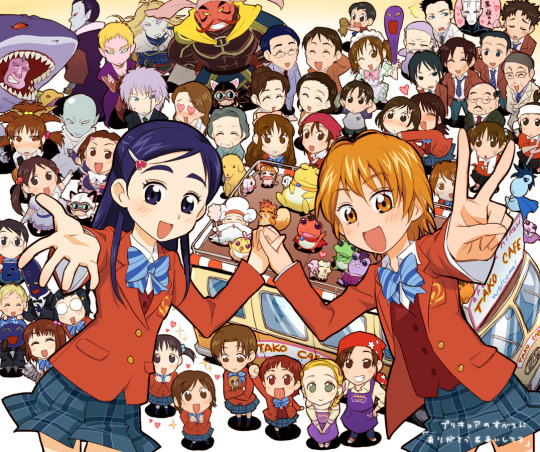
2010
#finds#mipple#yukishiro sanae#yukishiro tarou#misumi takashi#circulas#misumi takeshi#kubota shiho#pisard#yukishiro aya#yukishiro honoka#kakuzawa ryuuichirou#zakenna#mori kyouko#misumi ryouta#uraganos#chuutarou#takenouchi yoshimi#koyama shouko#fujimura shougo#fujita akane#ilkuubo#baldez#kujou hikaru#misumi nagisa#odajima yuka#viblis#lulun#mepple#porun
0 notes
Text
Some fwp girls
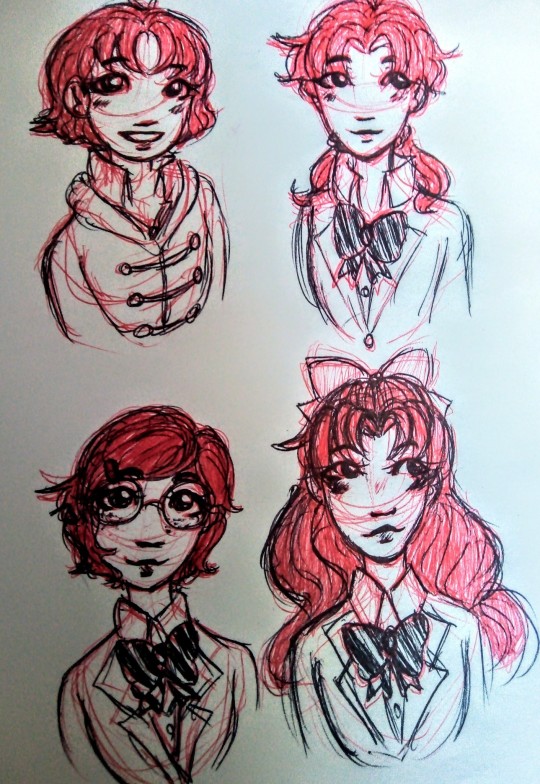
#futari wa pretty cure#futari wa pretty cure max heart#shiho kubota#rina takashimizu#yuriko#odajima yuka#my art#traditional art
8 notes
·
View notes
Photo

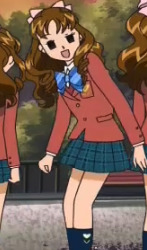
12 notes
·
View notes
Text
Uh Nagisa totally had a crush on Yuka Odajima. She was so sad when she thought the girl didnt like her! So impressed by her raw talent!
#precure#futari wa precure#pretty cure#not saying they should date or anything but im ten minutes through this episode and nagisa is crushing
8 notes
·
View notes
Photo
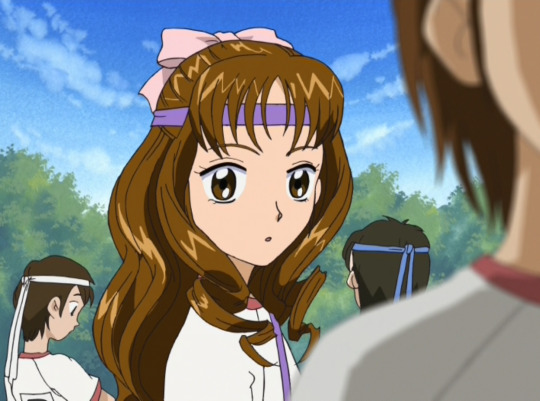
ODAJIMA YUKA RETURNS NEXT EPISODE! She was only in one episode before this. Episode 15... 18 episodes ago.
#futari wa pretty cure#precure#i wanted her to get close to nagisa and honoka#since she wanted to escape the pressure of having to be perfect in everything
6 notes
·
View notes
Text
Nagisa: Honoka, I think Odajima-senpai hates me D:
Odajima Yuka, a whole lesbian: if I see Misumi-san doing one more cute thing I might explode
#pretty cure#futari wa precure#sjfklfks#i don't blame these girls Nagisa is genuinly endearing#baby girl. baby#precure: futari wa
3 notes
·
View notes
Text
Precure Bonus Day: “Futari wa" Era Overview

Across the last year and 4 months, I rewatched all of the Futari wa Precure branded shows that ran from 2004-2007. These three shows form the foundation of the Pretty Cure franchise that currently spans 16 television series, 27 movies, and multiple stage shows. The end of the FW era marks the beginning of a shift away from the franchise’s roots, so before I dive into Yes! Precure 5 and beyond, I want to take the time to reflect and analyze the past three seasons as a whole. What did they have in common? What aspects did they change? Where did each show succeed and fail, and what common threads are there between these successes and failures?
Hopefully it goes without saying that there will be spoilers, but just in case, I will be discussing each of these series in their entireity, including plot twists and details about their finales.
Futari wa Precure (2004)
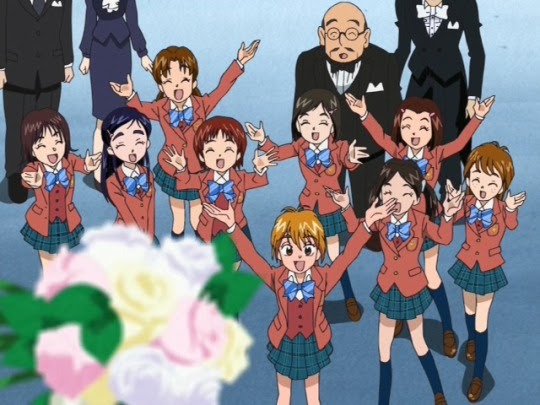
Obviously, this is the show that kicked it all off. Toei made this two years after their highly popular Ojamajo Doremi series ended, with the gap year 2003 being filled with a non-magical girl shoujo anime called Ashita no Nadja. I don’t think they meant to start a franchise, and honestly I don’t think they even meant to make it a year-long show. The plot wraps up pretty nicely in episode 26: Nagisa and Honoka have defeated all the henchmen and the main villain and they can return to their normal lives, having become great friends along the way. However, it was popular and the merchandise sold well, so they continued it. At least that’s my theory, maybe it really was meant to be an annual show, but the back half feels extremely stagnant and not particularly connected to the first half. They changed the objective, changed the villains, and the animation quality went down the toilet.
Nonetheless, it established important concepts for this era: most obviously, the two-girl team. It’s in the title: “We Two are Pretty Cure” (there’s a reason you don’t see it translated much, lol) The two girls also come from different walks of life, and would probably not have much reason to interact if it weren’t for being Precure. This first season in particular establishes something of a yin-yang theme with the two. Short hair and long hair, sporty and scientific, middle class and upper class, black and white. While less prominent, this idea of girls from diverse backgrounds coming together will remain a theme well beyond the FW era, to the point where the current (as of this writing) team consists of two space aliens. A key element of the two-girl teams is that they have to transform together. They cannot operate as individuals; they are a pair and they are strongest when they work together. From a writing standpoint, this is an excellent idea that allows for a lot of scenarios that can test and strengthen their partnership.
Another big aspect of FWPC is the supporting cast that flesh out the world. Nagisa and Honoka have friends other than each other, who sometimes have their own story arcs despite not being the main characters. Shiho stands out from this series, as we saw her develop and explore an interest in theater, but possibly the unexpected breakout character was Odajima Yuka. I’m getting ahead of myself, because she didn’t really click with me until her single appearance in Max Heart, but that wouldn’t have been meaningful without her sporadic presence in this show. There are also a half dozen other characters who get a focus episode and then recur in the background throughout the show, and I love the consistency. The girls have love interests and we get to see them wrestle with their feelings. It all makes the girls feel more ordinary, despite their secret lives as superheroes. They have normal lives with normal problems. The girls aren’t the center of the universe, they just happen to be the focus of the show, and there are lots of other people that also inhabit it, going about their lives, whose paths sometimes cross with the main characters’.
FWPC established a bit of a trend for the villain faction: they were fronted by a big, giant monster of literal darkness and each of the subordinate generals has a portion of the macguffin. Each general had a gimmick in how they plotted and attacked, be it brute force, overwrought scheming, subterfuge, or infiltration. The inevitable result of this was that some villains felt more interesting than each other, of course. Pisard and Gekidrago were nothing but archetypes. Poisony had a personality, because she played off of her brother Kiriya, and he had his own arc where he learned to appreciate the good side of humanity. Ilkubo combines aspects of several of them, being extremely powerful and basically the Dark King’s right hand, but for all his gesturing he doesn’t amount to much. The Three Seeds of Darkness from the second half of the show have less going for them. They have personality quirks but they’re not particularly memorable as characters. A lot of their time was spent sitting around saying “We need to find the macguffin.” Their most interesting moment was when they realized that they would be consumed by the Dark King, and tried to betray him (unsuccessfully), otherwise they were just kind of there to pad out the series.
Aside from the down-to-earth nature of the characters and the world, the other biggest element that FW gives us, which the series became famous for, is the fighting. The show’s director, Nishio Daisuke, had recently come off of work on the Dragon Ball series, and he went into Precure with the mindset that “girls like action too.” The combat is physical, the girls kick and punch the monsters rather than fighting with magic wands or special attacks, except for the finisher. This set Precure apart from the crowd and I honestly think it was a big contributor to its early success. It offered little girls something they didn’t often get without branching out into the other Sunday morning offerings, which were targeted at boys. Nishio was good at directing action and he made the fights entertaining to watch.
The major failures of FWPC are some truncated character arcs. Kiriya deserved better than to be forgotten halfway through the series, only to come back as something of a guiding spirit at the end and then die an unsatisfying death. Yumiko (the lacrosse captain) was completely forgettable despite the show trying to make her a notable recurring character. Some of the early guest characters of the week had really lame reasons to exist, like Mayu (the girl who looked like Nagisa). The Seeds of Darkness were utterly lame villains so the second half of the show feels less compelling than the first half. Also, the ending is just kind of strange. Mipple, Mepple, and Porun go to sleep seemingly forever, and Nagisa and Honoka’s graduation feels bittersweet when they think about that and see a boy that looks like Kiriya. I’m still not sure if the ending was so sad because they knew the sequel was coming or despite it, so if it’s the former, it’s a strange choice that only kinda works if they knew that the audience knew that Max Heart would be starting the next week and all the sad stuff would be undone. If it’s the latter, then it’s a bold choice to have a downer ending that was undercut by the show’s own popularity. Either way, I don’t think it was effective given the direction Max Heart took. Without Max Heart I’d consider it strong, but I can’t ignore the effect of the sequel. Art doesn’t exist in a vacuum.
Futari wa Precure Max Heart (2005)

Max Heart is an interesting animal. As the sequel to a fairly closed-ended series, it has to invent a reason to exist and uh.... it doesn’t do that very well. The Dark King apparently attacked the Queen of Light before his defeat, and now a few months later she dies and splits into her life, heart, and 12 wills, each of which are marketable in their own way. It essentially turns into another Macguffin quest, but the girls aren’t even actively seeking out the Heartiels, they just come to them. And unlike FWPC’s quest which wrapped up in the first half of that show, they stretch this one out for the entire season, so it gets tiring. That’s my big criticism of MH, but it’s not all bad.
Nagisa and Honoka were enjoyable characters in the first season and I am beyond delighted to get to spend another year with them. This season sees them deepening their friendship as they deal with their new leadership positions in their clubs, offering advice to underclassmen who are struggling with issues they dealt with in the first season, and further exploring Nagisa’s romantic feelings. She finally confesses to Fuji-P at the end of the show, even if he doesn’t actually hear her and consequently nothing comes from it. Season 1 Nagisa would never have gotten that far. Honoka’s development is rather subdued. She learns how to be a good club leader, and in episode 17 she helps push the club out of safe territory for the sake of their passion, but there’s really not much else to be said. She acts as Nagisa’s life coach sometimes when she has anxiety about her future, and helps her confess to Fuji-P, but she really does take a backseat this season next to Hikari. With that said, let’s talk about Hikari!
Hikari is, of course, a new character for this show, and thus her character arc is the most prominent of the trio. She also has more room to grow, since she starts out as basically an empty shell. Even if she is the Queen’s Life, she fully develops into her own person with her own life, friends, interests, and personality. Her overall kindness is probably a side effect of the Queen but she’s still not the Queen. She goes to school, makes friends, gets a job, builds a family, and generally discovers the joy of life. She’s a really enjoyable character to follow, because her journey isn’t just friendship like Nagisa and Honoka’s was, but becoming human. The tragic irony of her character is that the more of an individual person she becomes, the closer the Queen’s resurrection is, which means losing Hikari, and by rights this should form the backbone of the show’s conflict, but they don’t really seem to get this until the last quarter. They raise the question periodically but they don’t give it the discussion it deserves, and that’s a major weakness of the series. They ignore the problem until they can’t anymore. If they had given the audience the sense that this was intentional, that they were actively ignoring the matter, then it could have been interesting. Unfortunately, we never get the sense that Nagisa and Honoka were deliberately ignoring the inevitable question, and it seemed more like they just didn’t care.
As Shiny Luminous, Hikari somewhat changes the team dynamic, but she’s also not just a third fighter like Black and White. She is less combative, except when she has to be, and instead her abilities are more support-oriented. She stays back and activates barriers, slows down the enemy’s movements, and powers up Black and White. Her lack of combat skills means that sometimes Black and White have to protect or save her during fights, which interrupts the flow of battle and can make the fights a bit more drawn out than in the first season. I appreciate what they were trying to do by adding Luminous, and I am not in any way calling her a bad addition to the team, but her particular skills aren’t a very good fit for the style of fights that this show was built on. A lot of times she hides away from fights instead of transforming, making her more vulnerable. It seems like the staff wrote themselves into a corner with that aspect of her, and weren’t sure how to properly utilize her abilities.
The villains in Max Heart are an odd bunch. They’re slightly more memorable than the Seeds of Darkness, but no more competent. Their fights are meaningless, because Baldez is the only one who understands what’s going on with Hikari and Hikaru and the Dark King’s resurrection, and he doesn’t explain anything to the other three, so sometimes they just straight up defy his orders because he hasn’t told them what their objective is. I’m fine with villain infighting but I want there to be a good reason, a clash of ideals or something, not just straight up lack of communication. They have personalities, but that doesn’t play into their fighting styles in any meaningful way. The most interesting thing about them is how they form a family around Hikaru, and try to nurture and protect him while he grows. It brings out the soft side in some of them at home, and causes them to lash out in anger if he comes in contact with the girls somehow. Watching how Hikaru grows and parallels Hikari’s growth was a nice subplot. I’ve never been certain if the audience was supposed to recognize that he was the Dark King’s life before they reveal it in the series, but I really hope they were. Hikaru goes from a carefree kid content with living in the manor to wanting to get out of the house and see more of the world, which leads him into contact with Hikari on a few occasions, spiking each of their innate powers. Since he’s younger, though, he never reaches Hikari’s level of emotional maturity, which actually makes him a little more tragic because he’s just a little kid who unknowingly hosts this great evil. He just wants to do his own thing. Fortunately, in the end he is able to have a life with Hikari and Akane, even after the Dark King is destroyed. Which brings me to.....
Baldez. The final arc where Baldez revives the Dark King and then reveals that he himself now has the power of the Dark King is a neat subversion on expectations. He was always the most mysterious villain of the bunch, he was absent for half of the series and when he was around he played his cards close to his chest. He encouraged Hikaru’s growth by stoking Hikari’s development, and got in the way of Uraganos, Circulas, and Viblis when they tried to defeat her outright. He was a large threat to the girls whenever he did appear, and in a lot of aspects he seems like a precursor to Gohyaan. Ultimately though I can’t say he left a big impression. Most of the time he sat around the mansion saying “They’re developing nicely, the Dark King’s revival is soon....” and rarely set foot on the battlefield. He had no personality to speak of, and didn’t answer to anybody, so he was just flat and boring.
The next thing I want to discuss about Max Heart are some continuing storylines. I discussed the evolution of Nagisa and Honoka’s characters, but their friends get some further development as well. Shiho comes to mind, of course. In the first season she flexed her creative muscles by directing the action version of Romeo and Juliet for the cultural festival. In the sequel she goes a step further, deciding that she wants to be a Hollywood movie director, and chooses to incorporate special effects into their school play. It’s not a lot, but since not a lot of the side characters even get a character arc, it sticks out. However, there’s one character from the first series who didn’t get much to work with who suddenly is a lot more interesting when she recurs in this season, and that is Odajima Yuka, which is especially surprising since she only appeared in one episode, but due to it, all her past appearances suddenly make more sense. This is the episode where she, as a high schooler, joins the middle school science and lacrosse teams on their annual retreat, and ends up challenging Nagisa in a game. She gets out there, works her hardest at a sport she’s never played, and goes toe to toe with the team’s star player. They never outright say this, but what Yuka needed was to be challenged, to compete against somebody at her level. In all of her encounters, Nagisa is the only person who can outrun her. Nagisa may be clumsy at times, but she excels at athletics and gives Yuka the challenge she craves. In fact I think Yuka even envied Nagisa’s laid-back lifestyle. It is remarkable to me that the writers brought her back for Max Heart at all, and saw fit to conclude her story. She was never an important character, but she was memorable, largely because of this season. Later seasons with more main characters tend to sideline their supporting cast, so it’s nice that a minor character gets this kind of focus.
Lastly, there was some attempt to develop Akane early on. There was a three episode arc where a man from her old job stopped by and the girls all thought he was trying to pull her back into an office job. In the end, she declined his offer but he was still interested in dating her. She seemed to take to the idea, and there had been some hints that she wanted to get married and have kids someday, but after this arc, her potential suitor was never seen again and nothing more ever came out of it, beyond her effectively adopting Hikari and Hikaru as her children. It would be interesting to see adult romance play out, even in the background. The first season had Ms. Yoshimi getting married but we never saw any of her life outside the classroom, so giving Akane a little bit more spotlight would have been nice. Sadly, this was not the direction the show took.
Max Heart also got the theatrical treatment, and the movies were honestly very good. Famously, it’s the only series to get two movies, because the first film was originally intended to be just a FWPC film. They share a premise of whisking the girls off to a different land to resolve a problem that the locals are having, and they have their friendship tested along the way before coming out as better and stronger friends than before, acquiring exclusive new forms to defeat the villains. These would become signature elements of all Precure movies.
As I said earlier, the ending to FWPC was very finite, and that was strange juxtaposed to the fact that there was an imminent second season. There’s some strange irony, then, that the finale to Max Heart, the final series that will ever follow this cast of characters, feels a lot more open. It ties off loose ends, of course, and Nagisa and Honoka graduate from middle school, but while it’s implied that Mepple and Mipple go to sleep again, and Hikari is gone after reviving the Queen, less than two minutes pass for the viewer before they find out she and Hikaru are living with Akane, and that all their fairies are awake and as energetic as ever. Even though there ultimately weren’t any shows with these characters, there is room for more. Could they have known what the franchise would become? Could they have had any idea that these characters would still be popular 15 years later?
Futari wa Precure Splash Star (2006)
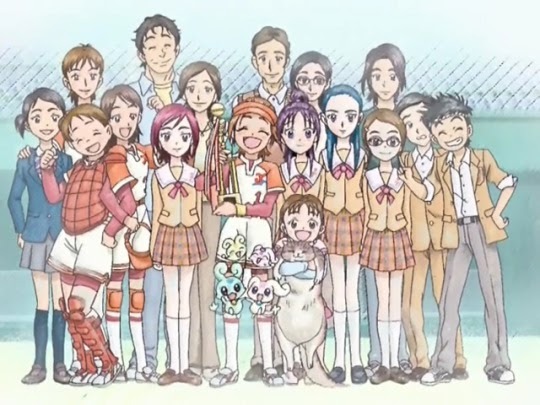
Splash Star is of course the first full reboot. I don’t know why, maybe they didn’t think they could continue the story of Nagisa and Honoka into high school. Could’ve been neat, but I’ll save the “what ifs” for another time. It rebooted the series, and that set a precedent for shows to follow. It keeps the two girl dynamic of course, and the visual similarities are hard to ignore, but those are fairly superficial, and it manages to find its own identity while improving on the ideas of the prior shows. The theme of the show changes from yin and yang to nature, and that affects everything: the aesthetics of the heroines and villains, the objectives they fight for, and most especially the combat style.
Once again, one girl is athletic while the other has a more academic hobby. Saki has two major friends on the softball team where Nagisa had two major friends on the lacrosse team, but Mai’s companion in the art club is less notable than Yuriko was to Honoka. This time they attend a coed school, and their circle of friends includes a couple of boys, as well as another girl who isn’t a member of either of their teams. Splash Star does the best job at managing its recurring and ensemble cast out of these three seasons. Characters are introduced, have their focus episode, and continue to make notable appearances, often hanging out with the main characters. Kenta even helped Miyasako find a hobby outside of being a class representative. They keep the number of recurring characters lower than FW/MH, use them in better roles, and the result is that they’re better developed and remembered. The romance plots are less fleshed out than in FW, but that’s about the only drawback. Also, Saki and Mai’s relationship with each other is much more immediate. Nagisa and Honoka took a few episodes to warm up to each other and only really cemented their friendship after a big fight, but Saki and Mai are fast friends by the second episode, and all attempts by the villains to introduce discord just backfire because they have absolute trust in each other.
The villains are also extremely fun and memorable. Whether you like them or not, they leave a distinct impression, much like the generals in the first half of FW. They have unique designs, quirky personalities, and at the end of the series we get to see them interact with each other. Karehaan was fairly straight-laced and I don’t like him much. Moerumba has a spicy personality, his problem is his short-sightedness. Dorodoron gets a laugh from me for being so timid. He might have been boring on his own, but he got to spitball with the Kiryuus, which helped him a lot. Miss Shitataare is powerful and cocky but completely inept. Kintolesky was easily my favorite of the lot, being honorable and straightforward and impeccably muscular. Aside from Karehaan’s overall blandness their biggest problem is not having enough cross talk with each other, with that being saved for their revival arc. Later shows do this a lot more often and better, thankfully.
Speaking of villains, however, Gohyaan stands out. He kind of serves multiple roles as both the comic relief of the villains, like the Zakenna Butlers, and as the right hand to the big bad. He spends most of his time sucking up to Akudaikaan, but occasionally he does go out on the field and demonstrates how powerful he actually is. His memorable personality and the twist where he reveals he’s the mastermind all make him a welcome addition. And just to reiterate, that twist had very minimal foreshadowing! Akudaikaan himself was the opposite, very not memorable, he’s blander than the Dark King, and that’s no easy feat. The most interesting thing about him is his physical design, as rather than being an amorphous blob like the Dark King, he has a defined face and a robe. His head resembles a Samurai helmet and a demon mask, and he has fire in his eyes. It’s a shame this theme didn’t really amount to anything.
Michiru and Kaoru’s redemption arc has to be the highlight of the show. The writers took some cues from Kiriya’s similar storyline in the first show but they gave the sisters a lot more time in the limelight, which allowed their characters to be better fleshed out. Over the course of the second quarter of the show, we get to see these girls go from a faux friendship with Saki and Mai into a legitimate one, because they actually listened and learned about the beauty of the natural world. They start to understand what it means to be cared for, to be appreciated for who you are, and not have your value be dependent on what you can provide for someone else. If more villains would take the time to see things from the perspective of the people they’re trying to defeat, they might also understand this, and truly some of them do. We’ll explore several types of redeemed villains in the shows to come, and I look forward to comparing and contrasting them with this. The biggest problem I have with the Kiryuus is that they were absent between episodes 25 and 41, and barely mentioned. Mai and Saki worried for them, and Miss Shitataare gave them hints that they were still alive, but it was sad to see them shoved aside for half the show with no particular explanation being given about what Gohyaan was doing with them. That’s my only major strike against Splash Star.
The fighting in the series is still punchy, but this time the spirits spice things up. There’s bursts of spirit energy whenever they kick and punch, they can concentrate the spirit power in certain parts of their bodies to jump farther, punch harder, and block attacks. As Bright and Windy they have elemental attacks using the light and wind. It’s an evolution of what the first series started, and I enjoy it. Finally, the victories feel meaningful, because every battle they get the reward of a Miracle Drop. Every seven episodes or so they collect enough drops to revive a fountain, and Princess Filia grows more and more complete. There is constant progress throughout the series, so even the slow parts of the show feel meaningful.
Of course, the series got a movie, and it was very similar to the prior two in overall plot: Tension arises between the two, they’re thrust into another world before they can resolve their feelings, the villain takes advantage of their personal conflict to overpower them, they get separated, then they make up with each other and come together stronger to defeat the villain. The closes they get to a movie form in this one is a glowing outline surrounded by the spirits of the zodiac, somewhat bucking the trend, but it’s an excellent movie. That really isn’t something I can say about all of them, so I’m grateful that these early films are so strong.
Splash Star has been described as the perfection of the Futari wa formula, and overall I have to agree. Of the three shows, it is the most consistent in all regards. There’s constant progression, character growth, meaningful supporting characters who you really sympathize with, and a fun and enjoyable cast of both heroes and villains. The first half of FWPC may be more fun, but the second half drags it down. Max Heart as a whole isn’t really sure where it wants to go. Splash Star sets a destination and arrives there at the right time, with some twists and turns along the way. I strongly recommend it to anyone trying to get into the series for the first time.
Unfortunately, despite Splash Star being arguably the best of the three seasons (both Eastern and Western fans ranked it above Max Heart), it tanked in sales after its first quarter, so it was decided that, if the franchise was going to continue, they needed a new look. Thus, they turned to the most enduringly popular magical girl series around for inspiration for their next season. But that’s a story for later.
Analysis
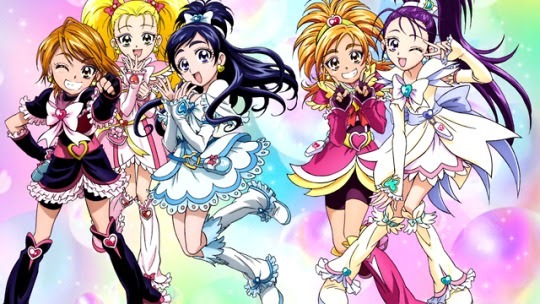
The most obvious shared elements between the three shows is the two-girl team, which they each used slightly differently. In FWPC, it’s the two of them against the world. That’s it. Max Heart switches things up with a third hero, who is not combative, but supports them, and they have to protect her at times, sidetracking their fights. Splash Star goes as far as to introduce two more fighters whose power stems from the darkness but they use it for good. They help the Cures out and the Cures help them out, but it’s Bloom and Egret at the core. The key aspect of this period of Precure is that the duo are regular girls who can only transform when they’re together, and that their powers become stronger when their feelings are in harmony. The shows each explore the pros and cons of this setup, concluding that their teamwork is the most powerful force in the word, and this is quite possibly the best thing to come out of this period of the series. The thing I especially like, however, is that being Pretty Cures means that the protagonists have an especially close bond with each other, moreso than their other friends. Since they have to transform and work together, they more intimately understand each other, and they share experiences their other friends will never know about. They look out for each other in every aspect of their daily lives, they have absolute trust in each other, and they will go through hell to protect each other. Pretty Cure’s most powerful weapon is friendship.
As far as their individual personalities go, Saki tends to be more optimistic than her counterpart. Nagisa is lovable and relatable as all heck, but she had kind of a pessimistic view of the world at times. It’s evident even in their catchphrases: Nagisa always says “I can’t believe this!” while Saki proclaims she’s “In top form!” Neither of them would ever hesitate to help a friend, and especially their partner, but during the daily grind Nagisa is more likely to be upset at her circumstances. Meanwhile, Honoka and Mai are even more dissimilar to each other. Honoka has a scientific mind, she’s very astute and good at picking up details. She kind of struggles with making friends but she tries to help people out, always, especially when they don’t want to help themselves. She puts up with a lot of crap but she will chew you out in the name of making you a better person. Mai, however, is observant but she tends to hyperfocus on one thing while drawing and space out a lot. She is a little timid but not afraid to express when she’s upset. Both Mai and Honoka serve to temper and balance out their more energetic partner, serving as the voice of reason when they get heated, and in general keeping them grounded. I love how, despite the differences in their friendships, both sets of partners help to round each other out and make each other better people. It’s a testament to what a good friend can do for you, and of course the central motif of the shows.
Consequently, other friendships form a big part of these shows, too. The small cast means that the girls have friends besides each other, and in each series we see how the protagonists influence their friends, their friends influence them, and we even get to see Hikari make new friends of her own. Again, all the shows handle this well, and it’s something that will be missed next season, since the larger team size means their friendships are more insular. Having friends outside the team grounds the shows in relatable situations as the protagonists go about their daily lives, hanging out with their friends who become beloved characters and get story arcs of their own. Shiho, Rina, Yuriko, Nao, Miu, Hitomi, Yuuko, Kenta, Miyasako, and Kayo are all memorable and important pillars of the shows. They encourage the leads when necessary, get into hijinks with them, explore their own interests, hang out, and have fun together. This also allows conflicts to be resolved without the Precure. In most superhero media the central conflict of the episode is between people’s feelings or beliefs rather than a physical altercation, but the fight usually resolves things somehow, while in Precure, since the combatants are often not the ones with a disagreement, it instead helps them figure out how to help their friends resolve their troubles.
Since these are the stories of regular girls dealing with regular adolescent issues, love is not a strange subject. Nagisa and Saki each had crushes on slightly older boys in their shows, and they handle it remarkably similarly. They get flustered, embarrassed, and have trouble even speaking to their partner about it. However, Honoka is shrewd enough to discern Nagisa’s feelings, while Mai never learns that Saki has a crush on her brother. The writers even approach their romances differently. Nagisa tends to be more proactive in exploring her feelings. She makes active efforts to make gifts for Fuji-P and confess her love to him, ultimately culminating in that fateful Max Heart Christmas episode where she yells it for all the world (but him) to hear. Meanwhile, Saki tended to just admire Kazuya from a distance, except when he came to her. She got jealous when it appeared he had a girlfriend, but she never acted on her affections in a direct way. I theorized that Fuji-P might actually suspect Nagisa’s feelings, and possibly share them, but he wants her to be ready to tell him. Meanwhile, as far as we can tell, while Kazuya finds Saki interesting, he doesn’t really see her as anything more than a friend. I like these different representations of young love, they show how much or how little of a priority it can have in someone’s life.
Famously, Honoka also got a brief pseudo-romance with Kiriya. She helped him grow as a person, he challenged some of her overbearing ways, but they clearly respected each other. She was distraught when he was taken back to the Dusk Zone, and that was one of the most heartfelt episodes in the entire series so far. There were echoes of his impact on her in the rest of the first series, but I never felt like they explored that story to its full potential, and he was not even mentioned in Max Heart. Mai never got a corresponding love interest, and Hikari’s love was more familial: for Nagisa and Honoka as her partners, for Akane as her guardian, and for Hikaru as the only person who could possibly understand her existential crisis. She learned about romantic love but never experienced it herself, which is fine. Girl has enough to worry about as it is.
The physical fighting pioneered in FWPC set the groundwork for the rest of the series, and you can see it slightly evolve over the course of these three shows. While FW is pure punching and kicking except for finishing moves, Max Heart introduces a character with support spells to help the team, and Splash Star gives the combat a bit of flair and style with the spirit trails and elemental attacks. Each show has carved out its own little niche, and I really think that’s one of the fascinating elements of the series. YPC5 will usher in special weapons, which are a genre staple that the original trilogy avoided. That will become standard for all series going forward, so these three shows with their almost entirely unarmed battles are a true highlight of early Precure to me. They manage to keep the fights interesting, always, it’s not just straightforward sparring. The girls do a lot of jumping around, flipping, fighting in sync with each other or tag-teaming. They always have to find weaknesses in monsters that are designed specifically to be hard to beat. Sometimes they’re fast, other times armored, or they’re heavily offensive, they have special abilities of their own, or the commander is threatening someone else. Always, the heroines find an innovative way to defeat their opponent and save the day in a visually exciting manner.
When it’s not showcasing awesome girls fighting for friendship and love, Precure is about selling toys. Bandai has a long history of designing toys to coincide with Toei’s Sunday morning shows, and they put their experience to work here. Nonetheless, they had some difficulty with the rather nondescript themes of the early shows, so the toys sometimes come across as very out-of-place. The transformation toys are generally cutesy enough to pass, the powerup braces stand out, the mid-season fairy’s compact forms are extremely gaudy (ESPECIALLY the Splash Commune, it’s literally just a computer in a show about nature), and the macguffin storage object of each show (Prism Hopish, Queen Chairect, Fairy Carafe) starts a proud Precure tradition of being a large, expensive toy first and a sacred artifact later. Additionally, there’s at least one object in each show that is Precure-branded merch in the real world which has no combat use and is forced into the plot of one episode before being quickly forgotten. As the years go on, the toys will be more unified with the theme of the show, and we’ll see some new patterns emerge.
One last element I realize that I forgot to bring up before now, but that becomes a franchise trend, is a trademark food and a restaurant of sorts. In FWPC and Max Heart, of course, their food of choice is takoyaki from Akane’s Tako Stand, where Hikari winds up working in Max Heart. Splash Star’s restaurant is Panpaka PAN, the Hyuuga family bakery, and their signature food is chocolate coronets. The restaurant or food stand is always a recurring location, where the girls and their friends often meet to talk and hang out and eat some delicious food. This is certainly not exclusive to Precure, or even the magical girl genre, as having recurring locations saves on the budget, both in animation and live-action, and food is an easy way to get people to congregate. Nonetheless, it’s sort of brought up in Precure All Stars, and there’s some truly great food ahead of us, so I wanted to point out that the trend goes all the way to the start of the series.
Obviously, 2004′s Futari wa Precure wasn’t intended to kick off a franchise, so when it got popular they stuck to what they knew for the second season. I’m not sure why they didn’t take the Doremi approach and keep aging them up a year for more seasons, but perhaps they thought they had exhausted the storytelling potential of the original cast and realized that it had franchise potential if they followed the annual reboot model of other superhero shows. The biggest issues with the first two shows are pacing, which is fixed in Splash Star, and you can see them tweaking and refining the formula in other ways through the three shows as well. If I had to describe this era in a word, relative to the overall franchise, it would be innovative. While the two-girl partnership would take a break for a few years after this, these shows laid the foundation for plot structure, villain organization, toy integration, and combat that would be utilized and enhanced by the rest of the franchise, so it’s cool to trace the roots of many Precure conventions back to their origins. What began as a humble action show for girls meant to sell some toys got popular, and continued past its intended conclusion. It was even referenced in other pop culture of the time.
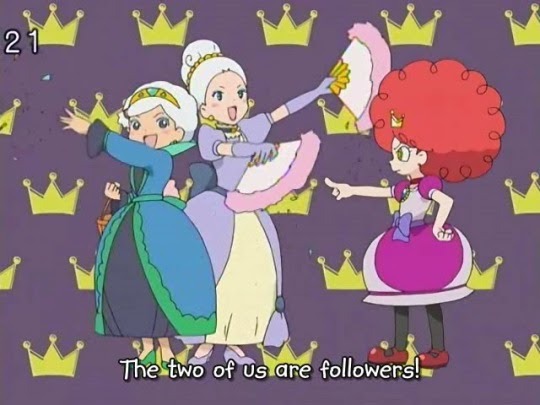
Powerpuff Girls Z (2006)
The series had gotten the attention of the masses and was a proven success. We got five memorable and lovable heroines, a bunch of beloved supporting characters, some wonderful villains, and even some welcoming food stands. Of course, there were bumps in the road. The series was still finding its footing during this period, and will continue to do so as we head into Yes 5, but without these three shows laying the groundwork for the franchise, I might not be here talking about it.
That’s my ode to the Futari Wa era of Precure, I hope you enjoyed it, I’m sorry that it took so long to get out. Look forward to Yes! Precure 5 reviews coming your way shortly, and remember:
Your best! My best! Ups and downs! Together We are Pretty Cure!
#Precure#Pretty Cure#Futari wa Precure#Futari wa Precure Max Heart#Futari wa Precure Splash Star#Precure Bonus Day#PCD Bonus
34 notes
·
View notes
Text
heta uma
AMAKANE Suzy – BAKI BAKI – EBISU Yoshikazu – FUKUSHI Chihiro – Fumics Pyoshifumix – GOTO Yuka – HAMADARAKA – HAMAGUCHI Sakurako – HANAKUMA Yusaku – HANAWA Masayoshi – HANAWA Kazuichi – HAYAKAWA Motohiro – HIROYUKI Nisogi – ICHASU – ICHIBA Daïsuke – ISHIKAWA Jiro – ICHIRINSYA – ITO Atsuhiro – KASAHARA Wataru – KATSUMATA Hideyuki – KAWAMURA Kozuke – KIKUSHI Hironori – KING TERRY YUMURA – MARUO Suehiro – MOTO Hideyasu – NAKAHARA Masaya – NANOOK – NEMOTO Takashi – NIROTAKA – NISOUGI Hiroyuki – NUKUMIZU Maya – ODAJIMA Hitoshi – OKADA Shigehiro – OKI Chu – OTA Keiti – PICOPICO – SAKABASHIRA Imiri – SEKITANI Norihiro – SHINTARO Kago – SHIRIAGARI Kotobuki – TAGAMI Masakatsu – TANAAMI Keiichi – TAWARAYA Tetsunori – TOMOZAWA Mimiyo – TSUZUKI Kyoichi – YAMANO Hajime
1 note
·
View note
Audio
(NoriSakamoto) J-pop
Song by YukaOdajima
Vocal Yuka Odajima
Produce Mix Mastering NoriSkamoto
0 notes
Photo


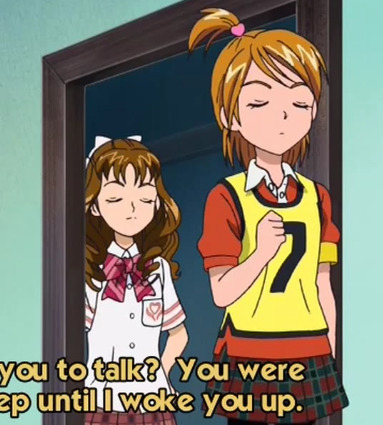
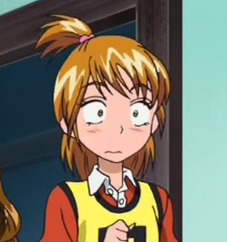
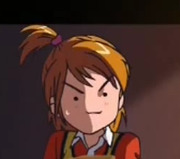
priceless screenshots
9 notes
·
View notes
Text
Futari wa Precure: Overview
What follows is my incomplete draft of the overview of FWPC that I attempted in summer of 2018 after finishing the first series. I eventually gave up on writing this in favor of continuing Max Heart and Splash Star, and when it came time to assess all of them collectively I decided to start from scratch, although you will find similar patterns of thought in both, because what I wanted to say didn’t really change. It ends abruptly when I couldn’t figure out where to go with it and didn’t want to revise what I already had, because it was consuming a lot of my time (sound familiar?). I have been sitting on this for over a year now, unsure of what to do, but I have finally decided to release it in this state, so you can get a look behind the scenes at my writing process.
Alright, it’s finally time. I’m going to look back over the entire FWPC series that I’ve just finished watching and evaluate it. What worked? What didn’t? What conventions were established that would be reused in future shows? Let’s dig in.
Main Characters

Nagisa and Honoka are really great characters to follow. Nagisa in particular breaks the protagonist mold a lot. She doesn’t really want to be a superhero, she just wants to go to school and laugh with her friends and play lacrosse and eat She wants an average life, and that’s commendable. However, she never once hesitates to put herself on the front lines when danger rears its head. When it comes to protecting her friends and family, she’s a mama bear. The contrast between her protective and easygoing sides may seem jarring, but I think it helps make her a more admirable, realistic character. Honoka, meanwhile, is not your everygirl protagonist, but represents a common archetype of the smart, bookish girl. She’s not quiet but she’s not outgoing like Nagisa, either. She loves to see people learn new things and readily shares her knowledge and passion on various subjects. What sets her apart from the stereotype is that she can be assertive, especially when she’s upset, and this is demonstrated well during her fight with Nagisa in episode 8, and again after she scolds Kiriya for being rude in episode 18. Superficially, the pair seem like a tomboy and girly-girl duo but to describe them as such does no favors to either of them. Nagisa wants to wear more mature, feminine clothes but finds that they don’t often suit her. Honoka, similarly, is not quaint and demure. She speaks her mind freely and gets caught up in some of Nagisa’s silliness. Both of them are deeply compassionate, with Nagisa being more protective and Honoka more nurturing.
Side Characters

Two of these girls would graduate to full Cure roles in subsequent seasons
Nagisa takes more of the show's focus and consequently so do her friends. Shiho and Rina appear much more frequently than Yuriko, and even Natsuko and Kyoko start popping up more often in the second half. I'd prefer a bit more balance, there were a bunch of named characters who only got one episode in the spotlight, and some didn't even get that. I'm thinking mainly of the lacrosse team captain Yumiko, who didn’t register with me when she was around and I didn’t even recognize her as the same character when she wasn’t in her lacrosse gear. (a brief aside, having two side characters with such similar names is very confusing). Ironically, despite being the most frequent recurring side characters, I remember the least about Shiho and Rina’s personalities. Shiho is memorable for her speech quirk of saying everything twice, but she and Rina only get one episode of focus and it’s a soft copy of episode 8, the big fight. What we get out of that one is that Shiho is very self-conscious and Rina can be a bit too hard on her teammates without meaning to. It’s something but it doesn’t really come through in most of their appearances before or after that episode. still, they’re fun to have around. Natsuko and Kyoko also always appear as a pair and are good with crafts, which aside from their cosplay episode, comes in handy during the class play and when they’re all making Ms. Yoshimi a quilt. The rest can be summarized quickly:
Kasiwada Mayu: Looks like Nagisa, likes art
Odajima Yuka: Good at everything, worried about her reputation
Taniguchi Seiko: Likes Kiriya, a little shy, can use the library
Morioka Yui: A bit outgoing, likes Fuji-P, can use the library
Fujimura Shougo: Good at soccer, nice
Kimata: Fuji-P’s friend. Open and shut.
Hasekura Kazuki: Overly assertive, womanizing. I think this is the first time I’ve actually used his name
Fairies
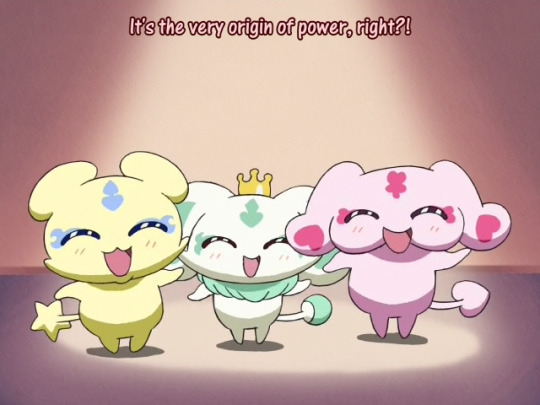
Mepple started out as kind of a jerk, and the whole overly lovey-dovey with Mipple schtick got old really quick. Thankfully, except for Max Heart, I don’t remember any subsequent seasons featuring romance between the mascots (Y5GG opted for Pretty Cure-Mascot relationships instead) so they learned their lesson on that front. Anyway, despite his immaturity, Mepple, like his partner, had a heart in the right place and was willing to put his life on the line occasionally. Sometimes. One time. Anyway, by series’ end I didn’t find him especially annoying, and of course I was sad at the part where he went to sleep for a week forever. (no I am not letting that go) Mipple is the more endearing of the two but aside from occasional good advice to Honoka she
5 notes
·
View notes
Text
Precure Day 074
Episode: Futari wa Precure Max Heart 24 - “Full-Throttle Youth! Yuka-Sempai and Nagisa’s Ultimate Battle!!”
Date watched: 7 October 2018
Original air date: 7 August 2005 (I don’t know why they went two weeks without an episode)
Screenshots: https://imgur.com/a/W9YpYpJ
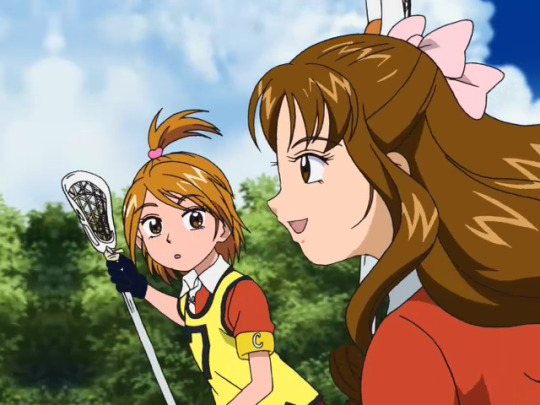
Hey guess who’s making a surprise guest appearance this episode? It’s Odajima Yuka! You might remember her from a few episodes of Futari wa where she was referred to as the Madonna of Verone Academy. She was a third year, and in this show she’s now a first year high schooler, but she decides to join the middle school on their summer trip on a whim. You see, Yuka has been lacking a certain something in her life, even she’s not entirely sure what, but she wants to revisit her old teammates. Now you may remember from the first season that Yuka was mentioned as being in the science club, tennis club, volleyball club, tea ceremoney club, English club, and ballet club, as well as being a flutist, so she was certainly keeping busy. Yuriko even comments that they rarely actually saw her because she was so busy with all of this. Well, you’d think she came here to spend a little time with the members of her former club but she ends up gravitating towards the lacrosse training. A talk with Hikari reveals that Nagisa has confessed to really admiring her, because being around Yuka gets her fired up, and with this in mind she gets roped into playing with the lacrosse team. Turns out she’s good at this too, despite never having played, but she gets really into it. She goes toe to toe with Nagisa and it brings out the best in both of them. They never outright say this in the episode but the implication is that Yuka needed to be challenged. This was touched on in the sports festival episode last season when Yuka was adamant about not losing to Nagisa in particular, and here it really comes to fruition. Unfortunately their practice is cut short, not by the Dusk Zone as you might expect, but by Nagisa passing out from exhaustion. Turns out she’d been losing a lot of sleep preparing the schedule for this trip. Yuka, Honoka, and Hikari tend to her for a bit but of course, this is a superhero show so the villains had to show up eventually, and they do right when Nagisa wakes up. The dark aura causes everybody who’s not blessed with the power of light to pass out, and the trio runs outside to discover Uraganos, who demands to know what happened to Baldez. Nagisa and Honoka transform while Hikari stays back, and after fighting the zakenna he made from their bus, Cure Black threatens Uraganos with their new power. Unfortunately she’s not sure how to summon it.
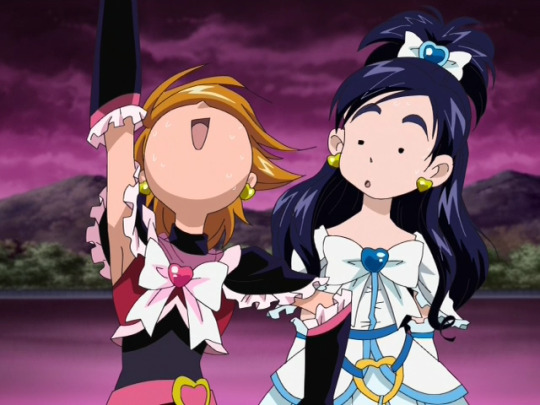
not like that
With some help from Seekun, the pair wish deeply for help from the power of nature and the power to create all things, and this summons the Sparkle Braces. They immediately attack with the Marble Screw Max, which Uraganos tries to block, but they turn it into the Spark and he quickly flees because he can tell he’s overpowered. The next morning, Yuka and Nagisa are bickering about oversleeping and who should have woken whom up, but it’s a friendly squabble. Yuka decides to go back home, having had her fill of excitement. Honoka comments that she probably just came to see Nagisa, which Nagisa doesn’t believe, but this is confirmed by the final lines of the episode:
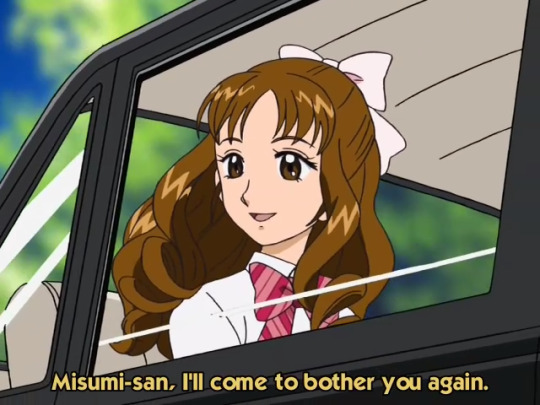
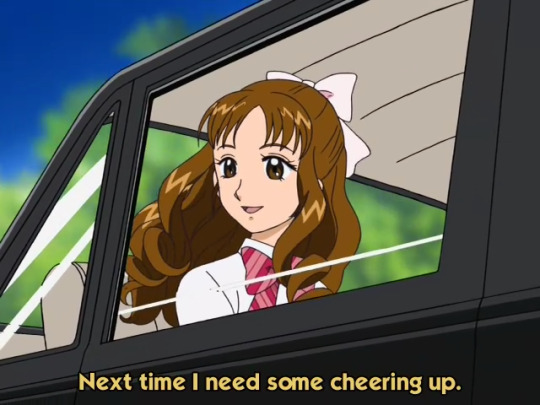
I’ll be honest, the first time I watched Max Heart I didn’t remember Yuka at all from when I had watched Futari wa a year or two prior. I firmly believe that she was underused in the first season, and she would have been delightful to see more than just three or four times. That being said, this episode is the perfect conclusion to her character arc. When we first met her in FW16 she felt burdened by her reputation as the Madonna, and although she scolded Nagisa and Honoka for being childish by dancing with the chalk erasers, there was a subtle sense that she wanted to let loose like that, which was manifested in her zakenna clones. In FW34, she develops a one-sided rivalry with Nagisa. She’s shown briefly in FW49 but not in any way that adds to her development. Finally, in this episode, we get the payoff to that rivalry as she puts aside her reputation and challenges Nagisa in order to get some fulfillment. She feeds off of Nagisa’s enthusiasm and Nagisa does the same for Yuka. They really complement each other and this is why I’d like it if Yuka appeared more in the show. I may be wrong (I was certainly wrong about this in the FW16 review) but I think this is her last appearance, being as she’s a high schooler now with few opportunities to interact with the middle school cast, and now more than ever I truly feel like that’s a missed opportunity.... but hey, missed opportunities are what Max Heart is all about.
Come back next time for the best grandma in the universe!
Pink Precure Catchphrase Count: 1 Arienai
10 notes
·
View notes